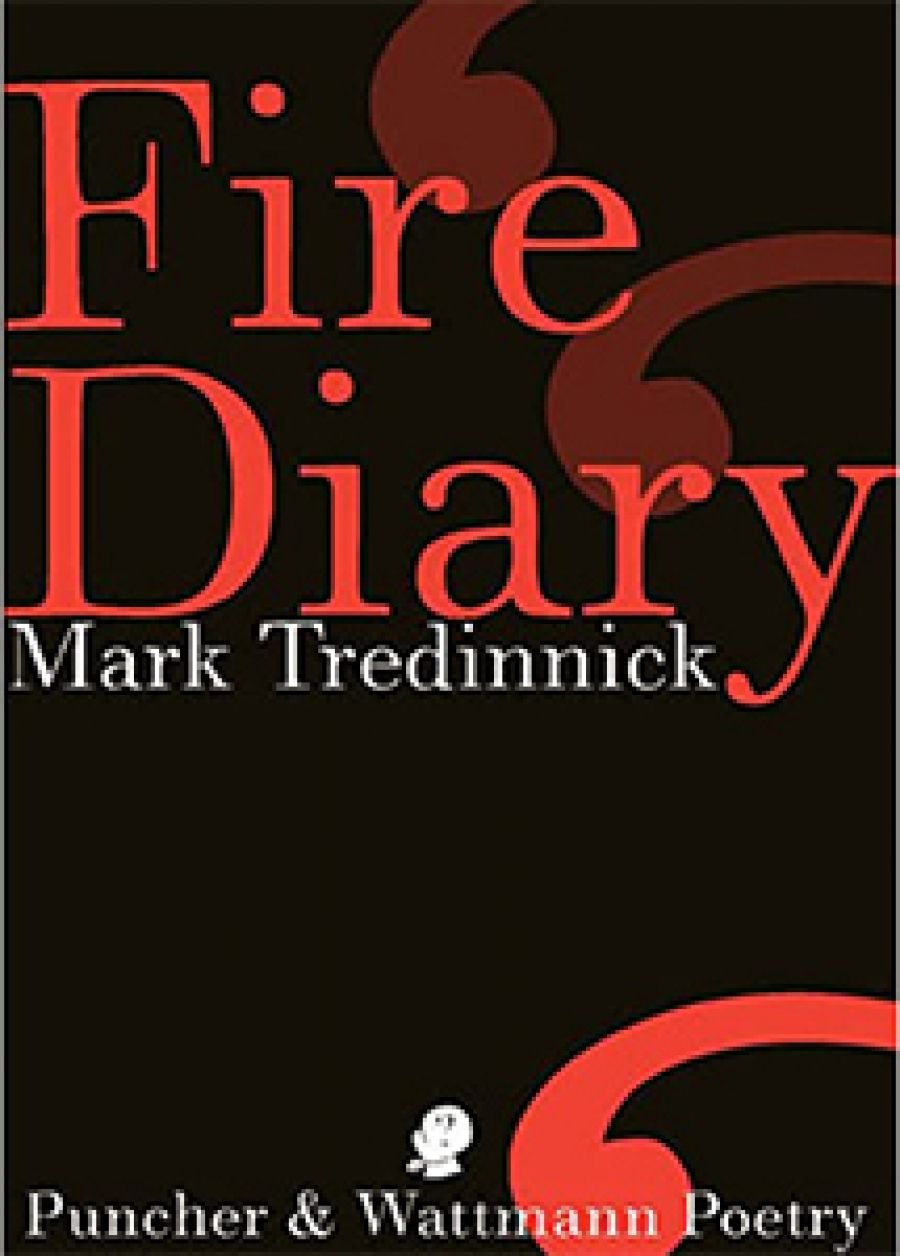
- Free Article: No
- Contents Category: Poetry
- Custom Article Title: Brendan Ryan reviews 'Fire Diary' by Mark Tredinnick
- Review Article: Yes
- Online Only: No
- Custom Highlight Text:
Mark Tredinnick’s much-anticipated first collection of poetry, Fire Diary, is an examination of place and how to respond to it. The title provides a clue to the form of the book; many poems chart the daily exigencies of living within nature. More importantly, the collection explores the moods and aspirations of the self ...
- Book 1 Title: Fire Diary
- Book 1 Biblio: Puncher & Wattmann, $24 pb, 105 pp
Tredinnick’s background as a nature writer (The Blue Plateau[2009]), and as editor (A Place on Earth [2003]), informs his use of language and poetic form. Many of his poems are eclogues – pastoral poems that celebrate the land, seasons, and nature. Unlike Les Murray’s poems of farming communities or John Kinsella’s anti-pastorals of the Western Australian wheatlands, Tredinnick’s poems traverse the stretch of land between house and writing shed, with an awareness of the nearby rural world that is often struggling financially. For Tredinnick, writing is an act where ‘it all starts over’ once the children are in bed, and where the pathos of a writer alone in a cowshed attains some importance. On a first reading, the lines of the poems appear relaxed and extend across the page in an open form, reasserting the nature writer’s essayistic mode. On the other hand, the syntax of Tredinnick’s language is tightened by qualifications such as these in ‘Things I’m Trying to Believe’: ‘Most of what I’ve / learned of love I haven’t learned yet, / and most of that is that most of love is loss.’ Tredinnick may wear his heart on his sleeve at times – a big risk in poetry – but his willingness to explore his subject, the natural world, will appeal to many readers.
A number of poems are accounts of walks, both literal and metaphorical excursions into the self and the natural world of the southern coast of New South Wales. The long lines replicate the action of walking and of allowing thoughts to be gradually extended. Just as Thoreau walked to think, Tredinnick is highly aware of the practice that he is pursuing: ‘a poem is country / and it needs you to keep walking it, and I walk out into it now’. Tredinnick is mining a long tradition of nature writers: Gary Snyder, Barry Lopez, Charles Wright, even A.R. Ammons (without his irascibility). Wright’s influence on Tredinnick may not only be with the extended lines, but also through sensibility to self and nature. Like Wright, Tredinnick’s register is both conversational and deeply lyrical. ‘Reading Charles Wright at Thirty Thousand Feet’ is not only homage to the poet; it is also an act of examining self-doubt.
The focus of a number of poems seems to be of grace found within the struggle of life, and of the paradoxes that surround the narrator. ‘I’m quiet within my family / the way the dams are quiet in the paddocks after rain.’ Repetition is often used for dry ironic effect, a bit like a quip between friends: ‘No one finished with last week; no one quite ready for the next.’ Christianity is questioned throughout, with Tredinnick’s use of lower case for god, and through his use of both gendered pronouns for the ‘Old Fella’. In the bardic poem ‘Brisbane River Blues’, Tredinnick reprises the well-known Ecclesiastes lyric ‘A Time to be born and a Time to Die’ with his own downbeat celebration of life: ‘There is a time / for cut grass and a time for asphalt and the smell of unleaded petrol.’ If anything, Tredinnick’s god is chthonic, since that is where hope has long resided, in ‘the basso profundo / of two or three brown-barrel gums’, and in ‘the music the stars have been reprising / in their erotic intervals from the start’. Heady stuff. Throughout the collection, Tredinnick takes risks with tone and style. It doesn’t always work, as in ‘Your feelings are gods / in the garden of your self’. The elevated tone and over-extended metaphor cloud the meaning within such lines. Many of the poems are set at night, with the moon assuming its teleological role. Women and children are either muses or the catalyst for poems, as in ‘Wingecarribee Eclogues’, where, ‘My daughter, not yet one / crawls to my chair and takes my pens’. Personally, I would have preferred more of the family life to enter into the poems, as a way of examining those human patterns. Like nature, they can also be parables.
Despite my reservations with some of the language within the collection, Fire Diary is sure to attract many readers. It seriously questions the self and our relationship to place, and, in doing so, emphasises that such questions may best be answered in poetry.


Comments powered by CComment